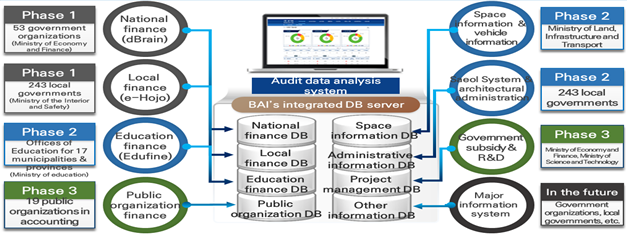
Digital Government
Case
Uncovering Concealed National Properties: Innovation in the Korean Board of Audit and Inspection’s Data-Driven Audits
September 14, 2020
Highlights
- The rapid growth in the quantity of digital information subject to audit and their increasingly complicated nature has required the innovation of the current audit system.
- The Korean Board of Audit and Inspection (BAI) built a data-driven audit system to (a) ensure effective and systematic analysis of massive data, (b) lessen the burden of auditees in submitting data, and (c) achieve efficient audits.
- This innovative data-driven audit system is proving to be especially effective now, with remote audits gaining importance due to the recent spread of COVID-19.
Ⅰ. Insight into the audit data analysis system (BARON)
The BAI has worked on devising new audit methodologies using digital data and information technology to better respond to the changing digitized audit environment. In October 2015, the BAI began to develop the audit data analysis system called the BARON, and through three phases, completed the system’s development in December 2017 (see Figure 1 below).
The BARON is designed to regularly receive and analyze digitized data that can be used in audit (financial data, data on government subsidies, geospatial data, etc.) from auditees, such as government organizations, local governments, and educational organizations through the information and communications network.

Source: BAI, Note: “DB” in the figure refers to “database.”
The BARON consists of the following four main functions to provide key data:
- The system restructures the data of auditees (linked to the BARON) for audit purposes and provides ‘Analyzed Contents’ that are the results of analysis from indicators, such as the risk of financial operation, data on the current status of auditees and problems found in audit scenarios. Analyzed contents are used for selecting auditees and initiating audits.
- The BARON provides the status on the auditee’s information system, as well as key audit information and digital data, such as the document register and data on accounts. This allows auditors to easily identify the status and problems of an audited entity.
- The system supports auditors to conduct easier database analyses (extract, compare, and cross-check data under specific conditions) on the data accumulated in the BARON or on the auditor’s own collected data.
- By searching and analyzing land and spatial data, the BARON provides auditors with information on buildings and land (status of construction, licensing, use, etc.), related regulations and building information (owner, type of use, etc.), and visualizes the information on the map for better analysis.
The development and operation of the BARON has brought significant changes to the BAI’s audit work. Before the system’s development, auditors needed to create the tables and forms to give to the auditees to collect audit data. Such work required considerable time and effort from auditees to fill in and submit data. However, the BARON enables auditors to effectively collect and analyze vast amounts of audit information and data. With easier access to such information, auditors can better draw out and analyze weak points and suspicious activities to use in their audits. The system also lessened the burden of auditees in submitting materials for audit, making the audit significantly more effective.
Ⅱ. Big data auditing reveals 310,000 unattended land parcels (8.5% of national properties)
With the amount from prior period adjustments[1] in the settlement of government accounts reaching an estimated KRW 53 trillion (about USD 45 billion) over the past 5 years, the BAI commenced an audit to identify causes of the mismatch and errors in the accounting and propose measures to secure the credibility of the national accounting system.
The audit team found that prior period adjustments mainly occur when the official in charge of state-owned properties realizes omitted or missing government-owned properties in the system and manually updates the information in the Digital Budget and Accounting System, (or the dBrain system) operated by the Ministry of Economy and Finance (MOEF). This finding signaled possible defects in the management of national properties, requiring an overall check on whether these properties are being properly managed without omissions.
The BAI decided to verify the accuracy of national property data in the dBrain system by cross-checking and analyzing 5.5 million cases in the dBrain system’s national property register with the 5.9 million cases in the real estate register of the Korea Real Estate Administration Intelligence System (KRAS) provided by the Ministry of Land, Infrastructure and Transport (MLIT). The BARON facilitated the analysis described and cross-matching of the relevant data because the system was linked to the data of both the KRAS and dBrain.

Figure 2. Big data analysis using the BARON
Source: BAI
By using the BARON, the audit successfully found 310,000 land parcels (8.5% of total national properties) that did not match. Based on the audit finding, the BAI notified the MOEF and related organizations to manage the national property list in a more accurate manner by periodically receiving information on the land register of KRAS. The use of BARON enabled auditors to promptly and accurately identify causes of the errors in the government’s financial statements and contribute to enhancing the credibility of the national accounting system through effective improvement measures.
III. Closing
Paper-based audit approaches do not allow for efficient, systematic analysis of big data. The BAI has taken this challenge brought on by the changing audit environment, including the need for remote auditing as a result of the COVID-19 crisis, and turned it into an opportunity to further innovate how BAI conducts data-driven audits. This need for innovation is applicable relevant for both internal and external auditors, and BAI hopes that our institution’s experience helps other auditors in their future endeavors.
[1] Profit and losses that occur when omitted or missing government properties in the prior fiscal year are found and updated in the current fiscal year.
| About the author LEE Kyungjae, Auditor, International Cooperation Division, BAI 13 years of experience working at the BAI for the Division of Planning and Management, the Busan Regional Office, Bureau II of Provincial and Local Governments Audit (Head of Team), Division I of IT Audit, among others. |
The views in this article are the author’s only, and do not necessarily represent the views of the OECD or its member countries.
Let’s Discuss
Digital Government
- You must be logged in to reply to this topic.

